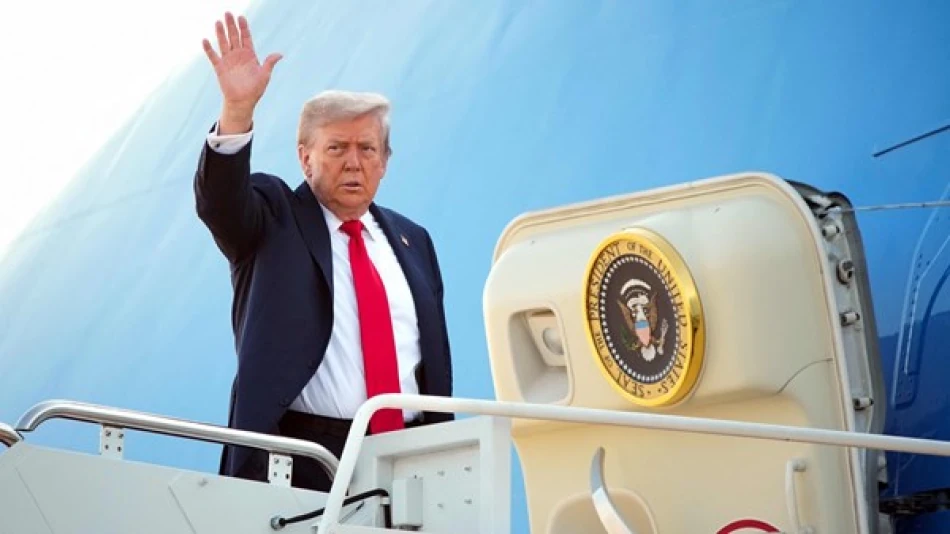
Trump Previews Putin Summit: Insights Ahead of Historic Meeting
Trump Sets High Stakes for Putin Summit: Ceasefire or Walk Away
President Donald Trump has drawn a clear red line ahead of his highly anticipated summit with Vladimir Putin in Alaska, declaring he will abandon negotiations if they fail to produce an immediate ceasefire in Ukraine. The bold ultimatum signals Trump's intention to pursue swift resolution to a conflict that has resisted diplomatic solutions for nearly three years, while raising questions about the feasibility of such rapid progress.
All-or-Nothing Diplomacy Takes Center Stage
Speaking to reporters aboard Air Force One en route to Alaska, Trump acknowledged the uncertainty surrounding the summit's prospects while maintaining firm expectations. "I don't know what will make the summit successful," he admitted, before adding his non-negotiable demand: "I want certain things. I want a ceasefire. I want the killing to stop."
The president's willingness to walk away from talks represents a departure from traditional diplomatic engagement, where initial meetings typically focus on establishing dialogue rather than achieving concrete breakthroughs. Trump's approach mirrors his previous negotiating style with North Korea and China, where he frequently threatened to abandon discussions if immediate progress wasn't achieved.
High-Risk Strategy in Complex Conflict
Historical Precedent for Summit Diplomacy
The Alaska venue carries symbolic weight, recalling the 1955 Geneva Summit and the 1986 Reykjavik Summit between Reagan and Gorbachev. However, those meetings occurred during different geopolitical contexts, with clearer bilateral frameworks between superpowers. The Ukraine conflict involves multiple stakeholders, including NATO allies, making rapid resolution significantly more complex.
Trump's demand for immediate results contrasts sharply with the incremental approach favored by previous administrations. The Minsk agreements of 2014 and 2015 required months of negotiation and ultimately failed to prevent renewed conflict, suggesting that sustainable ceasefires in Ukraine require extensive groundwork and verification mechanisms.
Putin's Position and Leverage
The Russian president enters the summit from a position of relative strength, having consolidated territorial gains while weathering international sanctions. Putin's historical negotiating pattern involves extracting maximum concessions before agreeing to de-escalation, making Trump's timeline ambitious.
Russia's demands likely include sanctions relief, recognition of territorial changes, and limitations on NATO expansion—issues that require congressional approval and allied consultation, not presidential decree.
Market and Global Implications
Financial markets have already begun pricing in potential outcomes, with energy futures fluctuating based on ceasefire speculation. A successful agreement could trigger significant commodity market shifts, particularly in grain and energy sectors where Ukraine and Russia play crucial roles.
European allies watch nervously, concerned that rapid bilateral agreements might bypass their security interests. The EU has invested heavily in Ukraine's resistance and reconstruction, making any settlement without European input potentially destabilizing for transatlantic relations.
The Feasibility Question
Military analysts suggest that meaningful ceasefires require weeks of preparation, including prisoner exchanges, humanitarian corridor establishment, and monitoring force deployment. Trump's expectation of same-day results may reflect either negotiating pressure tactics or underestimation of implementation complexities.
The president's "walk away" threat could strengthen his negotiating position by demonstrating resolve, but it also risks appearing unrealistic given the conflict's deep-rooted nature. Success will likely depend on whether both leaders view the summit as a starting point for intensive follow-up negotiations rather than a standalone solution.
The stakes extend far beyond Ukraine, potentially reshaping U.S.-Russia relations and establishing precedents for resolving future conflicts through direct presidential diplomacy.
Most Viewed News

 Layla Al Mansoori
Layla Al Mansoori






